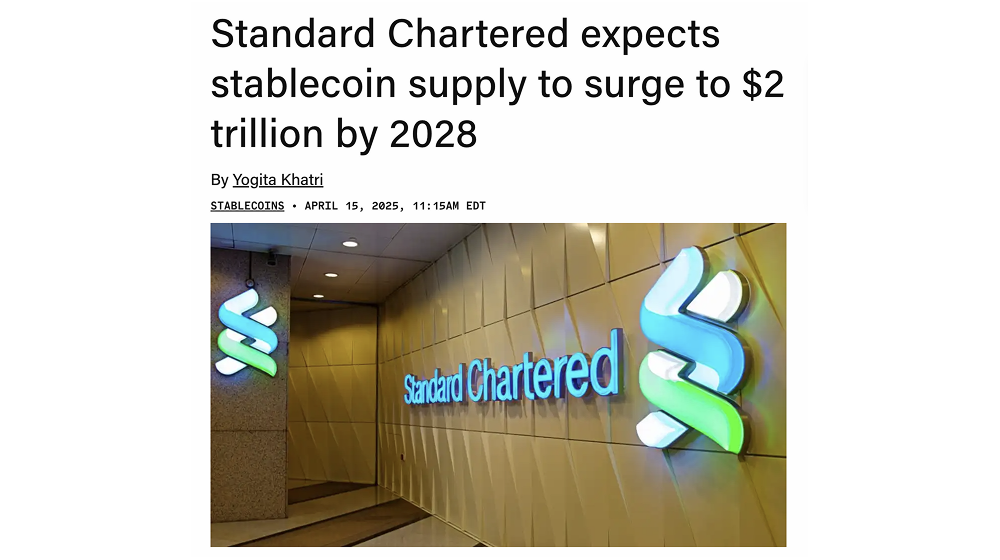According to a recent report from Standard Chartered Bank cited by The Block, the total supply of global stablecoins is expected to reach $2 trillion by the end of 2028, growing nearly tenfold from the current $230 billion. This forecast is bolstered by the upcoming passage of the GENIUS Act (Guiding and Establishing National Innovation for U.S. Stablecoins), which will provide a legal framework for the stablecoin industry and accelerate its mainstream adoption. The report also notes that stablecoin issuers may purchase up to $1.6 trillion in U.S. Treasury securities as reserve assets, enough to absorb all newly issued Treasury securities during Trump's second term. By 2025, breakthroughs in regulation, technology, and application scenarios will lay a solid foundation for future growth in the stablecoin market. This article will review the key developments in the stablecoin market in 2025 and explore their profound impact on the global financial system in conjunction with Standard Chartered Bank's predictions.

2025 Stablecoin Market Review: A Turning Point Towards Mainstream
In 2025, the stablecoin market experienced significant growth and transformation, gradually integrating from a peripheral tool of cryptocurrency into the global financial system. According to industry data, by the first quarter of 2025, the global circulation of stablecoins had risen to $215 billion, with on-chain transaction volume reaching $5.6 trillion in 2024, accounting for nearly 50% of global cryptocurrency trading volume.
Regulatory Breakthrough: The GENIUS Act Leads Compliance
In 2025, the advancement of the U.S. stablecoin regulatory framework became a core driving force for industry development. In March, the U.S. Senate Banking Committee passed the GENIUS Act with a vote of 18 to 6. This act establishes clear licensing and regulatory requirements for stablecoin issuers, including 1:1 reserves in U.S. dollars or highly liquid assets, strict anti-money laundering (AML) and know your customer (KYC) compliance standards, and direct oversight of large issuers by the Federal Reserve and the Office of the Comptroller of the Currency (OCC). The act also allows state-level regulators to oversee issuers with a market capitalization below $10 billion, lowering the entry barriers for small and medium-sized enterprises.
At the same time, the STABLE Act (Stablecoin Transparency and Accountability for Ledger Economy Act) also entered the review stage in the House of Representatives. This act further emphasizes the positioning of stablecoins as payment tools, prohibiting issuers from offering interest or returns to avoid their use as investment products. 
Accelerated Involvement of Traditional Institutions and Tech Giants
In 2025, the stablecoin market welcomed widespread participation from traditional financial institutions and tech giants, further promoting its mainstream adoption. Circle (the issuer of USDC) plans to submit an IPO application in 2025, with its reserve transparency becoming an industry benchmark. Tether (USDT), leveraging its market dominance, accounted for nearly 70% of the stablecoin market share in 2024, continuing to solidify its leading position. Additionally, after launching PYUSD in 2023, PayPal integrated it into its global payment network in 2025, significantly enhancing the application of stablecoins in retail payments.
The collaboration between Stripe and Remote.com became a highlight of 2025. At the end of 2024, Stripe launched a global payroll payment service based on USDC, covering 69 countries and reducing cross-border payment costs from the traditional channels' 8-12% to below 3%. This service gained popularity among freelancers in the tech industry and emerging markets, especially in sub-Saharan Africa and Latin America.
Stablecoin Boom in Emerging Markets
In 2025, the application of stablecoins in emerging markets showed explosive growth. In sub-Saharan Africa, the use of stablecoins in remittances and B2B transactions significantly increased, with transaction costs greatly reduced. For example, Nigeria received over $59 billion in cryptocurrency in 2024, with stablecoin transactions accounting for 43%. In high-inflation countries like Argentina and Turkey, stablecoins became a key tool against currency devaluation, allowing residents to obtain a dollarized store of value through stablecoins. Data from 2025 indicated a 35% increase in the adoption rate of stablecoins in these markets, making them an important complement to the traditional banking system.
Deep Integration of Stablecoins and the U.S. Treasury Market
In 2025, the demand for U.S. Treasury securities from stablecoin issuers significantly increased, providing high liquidity support for their reserve assets. Circle's reserve management model became the industry standard, with 88% of its reserves invested in Treasury securities with an average maturity of 12 days. The GENIUS Act requires that reserve assets have a maturity of no more than 93 days, further promoting this trend. Standard Chartered Bank predicts that by 2028, stablecoin issuers may hold $1.6 trillion in Treasury securities, enough to absorb all newly issued short-term Treasury bonds during Trump's second term.
Senator Elizabeth Warren criticized the GENIUS Act for its shortcomings in anti-money laundering and consumer protection, arguing that it could facilitate illegal financing. Additionally, the behavior of stablecoin issuers investing in money market funds and uninsured bank deposits could trigger liquidity crises under market pressure.
Future Outlook: Reshaping the Global Payment System
The stablecoin market in 2025 laid a solid foundation for the $2 trillion target by 2028. Improvements in the regulatory environment, widespread institutional participation, and explosive demand from emerging markets collectively drove the transformation of stablecoins from peripheral tools to pillars of the global payment system. However, their future development needs to find a balance between innovation and risk management. The final implementation of the GENIUS Act and the STABLE Act will determine the global competitiveness of the U.S. stablecoin industry, while the regulatory attitudes of regions such as the EU and Asia will also influence its internationalization process.
This article represents the author's personal views and does not reflect the position or views of this platform. This article is for informational sharing only and does not constitute any investment advice to anyone.
AiCoin official website: aicoin.com
Telegram: t.me/aicoincn
Twitter: x.com/AiCoinzh
Email: support@aicoin.com
Group chat: Customer Service Yingying、Customer Service KK
免责声明:本文章仅代表作者个人观点,不代表本平台的立场和观点。本文章仅供信息分享,不构成对任何人的任何投资建议。用户与作者之间的任何争议,与本平台无关。如网页中刊载的文章或图片涉及侵权,请提供相关的权利证明和身份证明发送邮件到support@aicoin.com,本平台相关工作人员将会进行核查。




